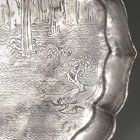J.J. Lally & Co., Oriental Art / New York City, New York
MenuPast Exhibition
Chinese Porcelain and Silver in the Song Dynasty
March 18 - April 8, 2002
18.
AN ENGRAVED SILVER ‘RED CLIFF’ PICTORIAL DISH
Song Dynasty, A.D. 13th Century
decorated with a scene from the Red Cliff Odes finely engraved in a painterly style showing the poet Su Dong Po in traditional court robes flanked by two companions relaxing in a boat moored on tranquil water, with a winepot and cups on the low table in front of them, one figure playing the flute and the other holding an open book engraved with three characters which may be read as qian chi bi, beside rocky banks shown with grasses and high reeds, a willow and a cassia tree, and with a cascade spilling down from high cliffs at the far shore, the sky with a pair of birds flying to the left towards a constellation of seven stars drawn as circles joined by thin lines to form the “Big Dipper”, seen through drifting clouds surrounding a full moon engraved with a rabbit shown standing on his hind legs under a tree on the moon, pounding a pestle in a mortar to mix his magic elixir, the shallow sides of octafoil bracket-lobed outline rising to a barbed rim, unevenly tarnished and with some minor losses to the edges from burial.
Diameter 10 3⁄8 inches (26.5 cm)
Su Dong Po (A.D. 1036 – 1101), also known as Su Shi, was one of the most famous literary figures of the Northern Song dynasty and his masterpiece, The Red Cliff Odes, is the most famous work of Chinese literature produced during the Song dynasty. In the first of the Red Cliff Odes, the poet tells the story of a boating party on an autumn night spent drinking wine, singing songs and discussing philosophical topics. As the poet and his friends enjoy the cool autumn breeze and the rustic scenery under a full moon, their mood changes from casual and joyful to melancholy and philosophical after listening to a song played on the flute and recalling an ancient battle fought under the Red Cliff. They mourn the rapid passage of time and man’s inability to control his own destiny, but confronting the insignificance of man in the universe and contemplating their own immanent mortality, they transcend their fears and once again find pleasure in drinking and the companionship of friends. The depiction of the poet in the center of the party on the boat engraved on the dish is entirely consistent with paintings of Su Dong Po produced in the Song dynasty. All of the details shown on the dish including the figure playing the flute, the wine drinking party on a boat under high cliffs, the full moon, the stars, and the birds flying south all refer specifically to the text of the first of the Red Cliff Odes and the three characters engraved on the book held by one figure in the boat: qian chi bi, which is the title of the first of the Red Cliff Odes, complete the identification of the scene.
Similar depictions of Su Dong Po’s Red Cliff Odes can be seen in Song dynasty paintings. Compare, for example, the painting by the Southern Song artist Li Sung, entitled The Red Cliff, which is in the Nelson Gallery-Atkins Museum, illustrated in Eight Dynasties of Chinese Painting, Cleveland, 1980, p. 54, no. 37, and the painting attributed to the late 12th century artist Wu Yuan-chih, also titled The Red Cliff, in the National Palace Museum, Taipei, illustrated in the catalogue of the travelling exhibition of Chinese art which toured several American Museums in 1961-62, Chinese Art Treasures, pp. 108-109, no. 46.
